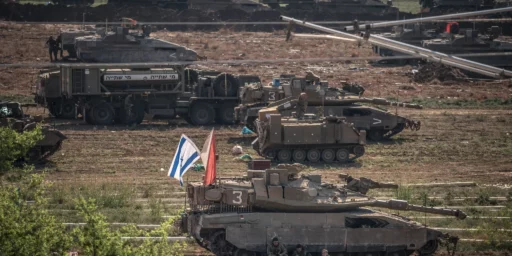Israel Conducts Kinetic Strike against Hamas Cyber Operations Center
This could be a very big deal - unless it isn't.
This could be a really big deal — apparently, according to media reports, the first kinetic strike on a cyber operations center in response to offensive cyber operations. The question is whether this will be seen as a one-off or the first example in the emergence of a new norm. And a second question is whether the cyber attack, if it was a cyber attack, was the trigger for the Israel Defense Force’s (IDF’s) use of kinetic fires — delivery of ordnance against a target — in self-defense.
The law of armed conflict, most of which developed long before the age of computers, is predictably silent on its application to cyberspace. Not surprisingly, law of armed conflict experts have had to analogize traditional concepts to cyber operations and cyber warfare. In an attempt to normalize some of the rules, even in a non-authoritative manner, the NATO Cooperative Cyber Defense Center of Excellence in Estonia commissioned a group of experts to gather to write a sort of restatement of the law. The result was known as the Tallinn Manual on the International Law Applicable to Cyber Warfare.

Rule 30 of the Tallinn Manual notes “a cyber attack is a cyber operation, whether offensive or defensive, that is reasonably expected to cause injury or death to persons or damage or destruction to object.” A cyber operation which rises to the level of a cyber attack, then, triggers the right to self defense under Article 51 of the UN Charter. In this case, if one assumes the IDF made a specific determination the Hamas cyber operation rose to the Rule 30 threshold, and then used force in response, that would be a case of first impression, at least in the unclassified arena.
Still, I’m a bit of a skeptic and want to see more facts unfold: if the cyber operation were directed from a “Hamas-controlled compound” and the IDF was already engaged in armed conflict with Hamas, and the Hamas-controlled compound were a legitimate military target for some other reason, such as being a Hamas command and control facility, the compound could have been targeted anyway under the law of armed conflict, regardless of the cyber attack. To me, at present, the nexus between the cyber operation and the IDF use of force is not clear enough to draw the link between the cyber attack and the kinetic response.
Finally, some commentators have been linking the US unmanned strike on ISIS leader and UK citizen Junaid Hussein as a kinetic strike against a cyber operator. Hussein was much more than merely a hacker, and the strike on him was carefully planned and grounded on his role as an ISIS leader, not solely on his hacking and cyber activities. In fact, the Hussein strike may serve as more of a precedent for decoupling the cyber operation from the kinetic fires, rather than as a precedent for linking them.
At some point, some military actor is going to conduct a cyber operation, and only a cyber operation, outside the context of an armed conflict, and another military actor is going to see it as an attack justifying self-defensive fires solely because of the cyber attack. I am just not as confident as the media that day was this week.






You may want to edit to actually explain what a Kinetic Strike is.
If I understand what you are trying to say, Israel, in response to a cyber attack, used an airstrike to knock out the origin of the cyber attack.
Hmm, does “damage or destruction to object” include wiping a disk drive or corrupting data on it, regardless of the value of that data? This could be interpreted very broadly, and people could start shooting, if they felt like it, over something that most people consider far less serious than setting off a car bomb or something.
For instance, during 2017 I rebooted my routers at the request of the FBI after it announced that it had tracked down and disabled a worm that was propagated by a state actor and sat on many routers. The FBI had managed to neutralize its ability to reorient after a restart, and so then asked everyone to reboot. I don’t think that caused any data corruption, but the disruption to service might have. I wouldn’t call this justification, but does that law cover a case like this?
What if someone drops a “hi there” into some websites metadata? Is that “damage”? What if I don’t change any data, but cut your bandwidth to ten percent of what it ought to be? Would that be “damage to property”, even if I can flip a switch and have the thing back to full speed?
This question intrigues me.
@SKI: Ditto “IDF.” (I assume that’s the Israeli Defense Force after I pondered it.) I appreciate your area expertise. Please remember most of your readers are generalists at best.
@Jay L Gischer: Right, so it’s complicated. There’s some duration and intensity calculations that must be made in determining whether the cyber attack really does trigger a right of self-defense. I didn’t summarize the entire issue here, for brevity, but do take a look at the Tallinn Manual, linked, and secondary commentary on the issue.
@SKI:
I think it means a conventional military strike.
But there’s a class of kinetic weapons, not many, which carry no explosives, and kill their target using kinetic energy only. Kinetic energy is one half the mass of the projectile times the square of its velocity. I think some anti-tank weapons qualify, certainly the bullet fired by the A-10 does.
Oh, hey, it could mean any attack with non-explosive projectiles, ie bullets.
In science fiction there are many such weapons imagined, as space travel involves prodigious speeds. Things like a ramscoop interstellar ship impacting a planet, or star, at 99.99999% the speed of light, or asteroids flung at high kps (kilometers per second) relative to a planet,
I believe ‘kinetic’ is milspeak for, ‘blowed shit up real good.’
@SKI:It may be late in the sequence, but the headline at the CNBC link says “Israel says it bombed Hamas compound that committed cyberattacks.”
Given the recent rocket and bomb exchange, I would guess that rule 20 applies, or there is at least enough uncertainty to claim it applies.
Steve
@michael reynolds:
“Kinetic” in this context means bombs and / or missiles.
Basically it milspeak exactly like you said.
For coming conflicts, after the tech is nailed, a kinetic weapon might well be a “dumb” steel rod shot from a rail gun whose purpose is to inflect damage on a target by means of energy transference from projectile to target (I.e. shooting a 2×4 via an air cannon at a structural wall in tornado or hurricane preparedness videos.
A reminder, perhaps, for the need for editors, and that people writing articles should not be in charge of selecting the headline.
It never ever occurred to me there could be this much misunderstanding over a word that so plainly means what it was intended to mean.
“kinetic strike” in this context is a very odd turn of phrase.
I believe you said this to me a few weeks back:
reading is fundamental
@ButchBracknell:
Dude, the commentariat here is a bunch of STEMies, a scattering of Hollywood people, a punk rocker, a kid book writer and a few people who need what we euphemistically call ‘memory care.’ Now, in my case, I will always seem to understand what you’re talking about, but this will not always be the case. OK, it will frequently not be the case. But I’ll always seem to – it’s my special gift.
“Now, in my case, I will always seem to understand what you’re talking about, but this will not always be the case. OK, it will frequently not be the case. But I’ll always seem to – it’s my special gift.”
Some of us cracked the code years ago.
@Guarneri:
And yet you never figured out that you can’t score off a self-deprecating remark.
You know every time you try to be clever it’s revealing, right?
@Guarneri: How’s that rental agreement with Reynolds for head space comin’ along? Any progress? Eviction notice? Anything?
@ButchBracknell:
I’m not sure when DoD and the natsec wonk community writ large started using “kinetic” but I don’t recall it before GWOT. In the olden days, “kinetic” seemed an unnecessary modifier. But we use the military for so much more than “killing people and breaking things” that we needed a way to distinguish those ops.
I gather, however, that most non-specialists haven’t grokked that we’re using a word that means “relating to or resulting from motion” to mean “intended to kill.”
I was enlisted back in the early 70s. Pretty sure the term kinetic was used back then. As an officer during Desert Storm I would swear we also used it back then too. It does seem to be used much more often now.
Steve
@James Joyner: James, I believe it’s when we started talking about effects based operations in which there were lethal and nonlethal effects in targeting — recognition the military’s Real Purpose is not necessarily to kill people and break things, but rather to cause adversaries and other actors (friendly, neutral, uncommitted) to do certain things, not do certain things, or do nothing at all. Sometimes that’s accomplished by blowing up a building with a bomb or killing enemy soldiers with rifles or dropping a bridge with high explosives. And sometimes it’s accomplished through information by encouraging groups to lay down their arms or encouraging farmers to give you information by planting a date grove or buying up their seasons harvest of rice.
Think about this: hackers can now get into car computers remotely and control the car: stop, speed up, slowdown! What else – airplanes? Trains?
When 5G gets here, things will get worse.
@ButchBracknell: I think that’s right, although I remain amused that we have to give those things pseduo-military names to make them seem more military. We don’t just use information. We conduct information operations! It’s like when the Corps decided that all the elements in a MAGTF should be called a “combat element,” which strikes me as silly and redundant. “No, logisticians aren’t combat support. They’re a full-fledged combat element!”
@ButchBracknell: Using the term “kinetic strike” immediately brings to mind the question “do you have non-kinetic strikes as well? And what are they?”
….then there’s all the other pseudo-technical terms the military could potentially use in order to try to impress people: bio-kinetic (bag of flaming poo thrown through window) , chemo-kinetic (Molotov cocktail) , maga-kinetic (blowing up sh*t even better!), nano-kinetic (blowing sneezing powder at someone)…..
No further comment.
@ButchBracknell:
You need to get out more. 🙂
Nowhere but within your narrow guild does “kinetic” plainly mean “intended to kill”. Everywhere else it means “in motion”. Nor has this use gotten play in the broader culture. Even if someone were to google “kinetic strike”, most links would be to a very distinct weapon like “Project Thor”. Ironically, the one exception in the high-up google results is this post.
We all have our guilds and the in-group speak that comes with them. If I’m talking about the “Seven Elements”, other compliance officers and white collar lawyers know I’m referring to the DOJ’s Sentencing Guideline’s key elements of a corporate compliance program necessary to get sentencing credit from a Judge or prosecutor. To us, that is the “plain meaning”. To everyone else (and google), they are likely thinking I’m talking about “Earth, Fire, Air, Water, Wood, Metal and Aether”. My suggestion is you try to minimize or at least explain these terms when you use them. If you have problems recognizing what those terms are, get someone from outside the guild to read it.
@grumpy realist: It’s a good question. We don’t have kinetic “strikes” but we do conduct non-kinetic operations. Info Ops and Psy Ops are two decent examples. And I agree with James — it’s likely an unnecessary term.
@SKI: Maybe your Google doesn’t work like mine. The second result when using the term “kinetic operation” is a Wikipedia article explaining the origin of the terms captured in Bob Woodward’s book “Bush at War.” Obama used to use it in Presidential speeches. So the fact you haven’t heard it doesn’t make it tribal speak exclusively.
@Butch Bracknell: As noted above, I used “kinetic strike” in my search – the phrase in your headline and your first paragraph but, since you appear to want to be snitty, after searching for “kinetic operation” on google (https://www.google.com/search?q=“kinetic+operation”), the top hits are military sites:
https://apps.dtic.mil/dtic/tr/fulltext/u2/1019178.pdf
https://grc-usmcu.libguides.com/pacific-challenge-2018/kinetic-operation
https://grc-usmcu.libguides.com/pacific-challenge-2018/nonkinetic-operation
https://apps.dtic.mil/dtic/tr/fulltext/u2/1019178.pdf
Not exactly the WaPo or the Times, let alone USAToday or pop culture.
@grumpy realist:
Actually, yes and the reason “kinetic” became a thing was to distinguish the difference. The split was because the DoD started looking at its operations a bit more holistically, and also to account for the fact that our operations increasingly included non-physical warfighting tasks that didn’t include killing people and breaking things. Some examples: information operations, key leader engagements, lawfare, and cyber operations/warfare. The focus is really on cyber though.
@Andy: @SKI: I agree that the term is not as common as Butch, not unreasonably given his circles, presumed. According to Wikipedia, my instinct was right: it’s really a GWOT-era coinage.
So, we can think Rummy for this one! But it caught on, with routine use by civilian officials of both parties, including Barack Obama.
@James Joyner: Not sure a handful of times a year counts as routine but I’ll desist. 🙂 Thanks.
It is a term that was unfamiliar with prior to this post.
One of the first things that I learned when I started teaching was that an essential component of my job was to figure out where my audience was so that I could move them forward to where I wanted them to be by the end.
Getting defensive when someone tells you that they don’t understand something you consider fundamental when you haven’t taken the time to explain it to them isn’t going to lead to success either in a classroom or in a persuasive essay.
I didn’t recognize the term immediately, but I thought it was clear by the end of the first paragraph.
And if you can’t be bothered to read the first paragraph, the picture of smoking buildings seemed clear.
It’s not the language I would have chosen, and it’s not common language outside of the kinetic and non-kinetic operations planning and execution community, but it’s mostly understandable from context.
——
It doesn’t surprise me that Israel would respond to a cyberattack by bombing the shit out of them. It does surprise me that Hamas has/had an effective cyberattack capability.
And, of course, it reminds me of how much of our infrastructure is weak to these attacks.
If Venezuela was attempting to hack RNC servers, and engaging in the same actions Russia is doing right now, we would likely use that as our excuse to invade.
Im reminded of an episode of Roseanne, where DJ was sticking his hand in Darla’s face at the dinner table until Darla finally smacked him. DJ complained “but I didn’t even touch her!” Dan barely looks up from his food before saying “well, it wasn’t really worth it then, was it?”